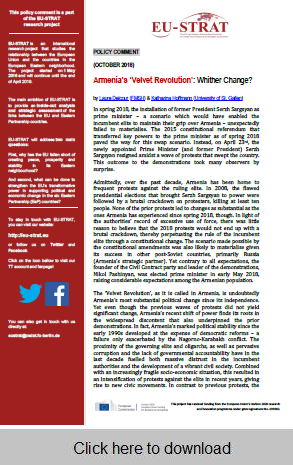Policy comment / October 2018
 Armenia’s ‘Velvet Revolution’: Whither Change?
Armenia’s ‘Velvet Revolution’: Whither Change?
by Laure Delcour & Katharina Hoffmann
“In spring 2018, the installation of former President Serzh Sargsyan as prime minister – a scenario which would have enabled the incumbent elite to maintain their grip over Armenia – unexpectedly failed to materialise. The 2015 constitutional referendum that transferred key powers to the prime minister as of spring 2018 paved the way for this swap scenario. Instead, on April 23rd, the newly appointed Prime Minister (and former President) Serzh Sargsyan resigned amidst a wave of protests that swept the country. This outcome to the demonstrations took many observers by surprise.
Admittedly, over the past decade, Armenia has been home to frequent protests against the ruling elite. In 2008, the flawed presidential elections that brought Serzh Sargsyan to power were followed by a brutal crackdown on protesters, killing at least ten people. None of the prior protests led to changes as substantial as the ones Armenia has experienced since spring 2018, though. In light of the authorities’ record of excessive use of force, there was little reason to believe that the 2018 protests would not end up with a brutal crackdown, thereby perpetuating the rule of the incumbent elite through a constitutional change. The scenario made possible by the constitutional amendments was also likely to materialise given its success in other post-Soviet countries, primarily Russia (Armenia’s strategic partner). Yet contrary to all expectations, the founder of the Civil Contract party and leader of the demonstrations, Nikol Pashinyan, was elected prime minister in early May 2018, raising considerable expectations among the Armenian population. ”
